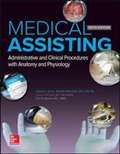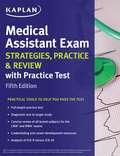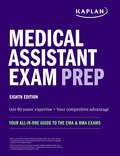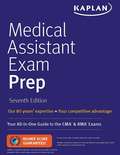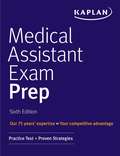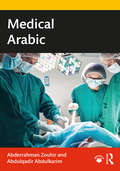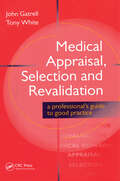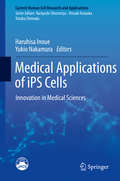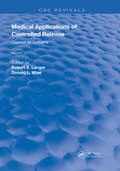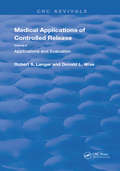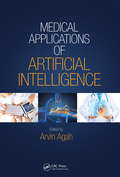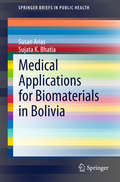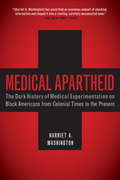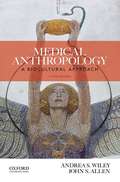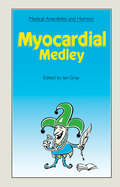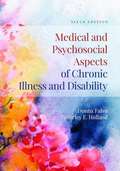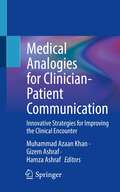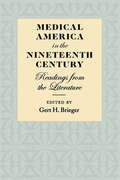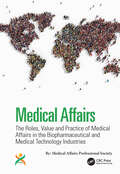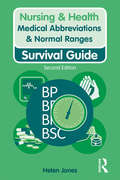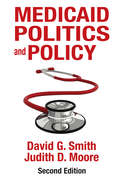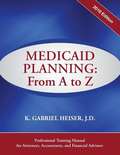- Table View
- List View
Medical Assisting: Administrative And Clinical Procedures With Anatomy And Physiology
by Kathryn A. Booth Terri D. Wyman Leesa WhickerThe medical assisting profession is soaring to new heights with the expansion and diversity of roles and changes in the healthcare environment. Today’s medical assistants must juggle many tasks in the medical office to keep up with the changes. The seventh edition of Medical Assisting:Administrative and Clinical Procedures with Anatomy and Physiology was updated to help students as well as instructors learn these ever-changing tasks and stay current in the healthcare environment.
Medical Assisting Administrative And Clinical Competencies (Seventh Edition)
by Barbara A. Wise Cathy Kelley-Arney Michelle BlesiMEDICAL ASSISTING: ADMINISTRATIVE AND CLINICAL COMPETENCIES, 7th Edition delivers all of the critical knowledge base, skills, and behaviors for entry-level medical assistants in an easy-to-understand, proven format. Newly streamlined for greater focus, the text also includes the latest in emergency preparedness, ICD-10, and electronic health records, and even personal effectiveness topics like professionalism and time management. Updated and innovative, the 7th Edition of MEDICAL ASSISTING: ADMINISTRATIVE AND CLINICAL COMPETENCIES uses multiple in-text features to prepare students for a successful career in medical assisting, and give them a significant advantage in today's competitive marketplace.
Medical Assistant Exam Strategies, Practice & Review with Practice Test
by KaplanEverything you need to pass the CMA and RMA exams.Medical Assistant Exam Strategies, Practice & Review with Practice Test provides targeted review and practice for the Certified Medical Assistant and Registered Medical Assistant exams, as well as a guide to the certification process.FEATURES:* Diagnostic test to target areas for score improvement* Review of all tested subjects for the CMA and RMA exams* End-of-chapter quizzes* Full-length practice test with 300 questions* Detailed answer explanations* Up-to-date information on exam content, structure, and registration* Analysis comparing/contrasting ICD-9 and ICD-10* Current guidelines for Electronic Health Records* Career-development resources for medical assistants* Guidance on building and maintaining professional credentials
Medical Assistant Exam Prep: Your All-in-One Guide to the CMA & RMA Exams (Kaplan Test Prep)
by Kaplan NursingKaplan's Medical Assistant Exam Prep provides the in-depth content, comprehensive review, and targeted practice you need to pass the Certified Medical Assistant and Registered Medical Assistant exams. Whether you're a first-time test taker or you're studying for recertification, Kaplan's up-to-date content and proven test-taking strategies will help you face the exam with confidence. Kaplan is so certain that Medical Assistant Exam Prep offers all the knowledge you need to pass the exam that we guarantee it: After studying with the book, you'll score higher on your medical assistant exam—or you'll get your money back.Comprehensive ReviewReview of all tested subjects for the Certified Medical Assistant (CMA) and Registered Medical Assistant (RMA) examsDiagnostic test to help you target areas for score improvement and make the most of your study timeFull-length practice test with 300 questionsEnd-of-chapter quizzes with detailed answer explanationsCase study–based practice questions to develop your critical thinking skills, now with 2 NEW case studies!Updated professional resources with advice for building an electronic portfolioNew discussions including: Covid-19, pediatric vaccinations, telehealthNew back-of-book Reference Guide with quick facts at your fingertips: normal vital signs, EKG leads & interpretation, order of draw, and moreExpert GuidanceExpert advice on building and maintaining professional credentialsUpdated career resources and a guide to the certification processWe invented test prep—Kaplan (www.kaptest.com) has been helping students for almost 80 years. Our proven strategies have helped legions of students achieve their dreams.
Medical Assistant Exam Prep: Your All-in-One Guide to the CMA & RMA Exams
by Kaplan NursingKaplan's Medical Assistant Exam Prep provides the in-depth content, comprehensive review, and targeted practice you need to pass the Certified Medical Assistant and Registered Medical Assistant exams. Whether you're a first-time test taker or you're studying for recertification, Kaplan's up-to-date content and proven test-taking strategies will help you face the exam with confidence.Comprehensive ReviewReview of all tested subjects for the CMA and RMA examsDiagnostic test to help you target areas for score improvement and make the most of your study timeFull-length practice test with 300 questionsEnd-of-chapter quizzes with detailed answer explanationsCase study–based practice questions to develop your critical thinking skillsNew discussions including: the medical assistant&’s role in emergency preparedness and the Patient-Centered Medical Home (PCMH) model of careUpdated discussions including: electronic health records (EHRs), personal health records (PHRs), and patient rights; guidelines for reporting healthcare data breaches; billing procedures; and day-to-day electronic communications in the medical officeExpert GuidanceExpert advice on building and maintaining professional credentialsUpdated career resources and a guide to the certification processWe invented test prep—Kaplan (www.kaptest.com) has been helping students for almost 80 years. Our proven strategies have helped legions of students achieve their dreams.
Medical Assistant Exam Prep: Practice Test + Proven Strategies
by Kaplan NursingKaplan's Medical Assistant Exam Prep provides the in-depth content, comprehensive review, and targeted practice you need to pass the Certified Medical Assistant and Registered Medical Assistant exams. Whether you're a first-time test taker or you're studying for recertification, Kaplan's up-to-date content and proven test-taking strategies will help you face the exam with confidence.Comprehensive ReviewReview of all tested subjects for the CMA and RMA exams, including a new nutrition chapter and a section on emerging public health issues that affect MAs on the jobDiagnostic test to help you target areas for score improvement and make the most of your study timeFull-length practice test with 300 questionsEnd-of-chapter quizzes with detailed answer explanationsCase study–based practice questions to develop your critical thinking skillsCurrent guidelines for Electronic Health RecordsExpert GuidanceExpert advice on building and maintaining professional credentialsUpdated career resources and a guide to the certification processWe invented test prep—Kaplan (www.kaptest.com) has been helping students for almost 80 years. Our proven strategies have helped legions of students achieve their dreams.The previous edition of this book was titled Medical Assistant Exam Strategies, Practice & Review with Practice Test.
Medical Aspects of Disability: A Handbook for the Rehabilitation Professional
by Herbert H. Zaretsky Myron G. Eisenberg Robert L. GlueckaufA comprehensive guide to disabilities for rehabilitation professionals.
Medical Arabic
by Abderrahman Zouhir Abdulqadir AbdulkarimMedical Arabic is a valuable resource for students interested in learning medical Arabic at ACTFL level Advanced Low. Effective communication is essential in health care, and communication is most effective when both parties share a common language, therefore resulting in a comfortable relationship between health care provider and patient. This textbook is intended for those with prior knowledge of Arabic language and grammar. It is designed to provide students with the linguistic and cultural competencies and medical Arabic terminology necessary to communicate in medical settings such as a hospital, clinic, or a community health care facility. Students will be able to ask questions in Arabic and provide answers in common medical situations, conduct patient interviews, and understand a wider variety of possible responses from patients. The book provides clear explanations of medical vocabulary and concepts as they occur in the reading materials to encourage active interaction with the text. The book’s drills are designed as either in-class exercises or homework. The answer key for the book exercises is also provided as a downloadable e-resource. Written by dynamic authors who taught Arabic as a foreign language for several years and reviewed by physicians and professionals in the field, the book is an essential guide for students in medical school, biology, and other science majors. Students will find Medical Arabic more than merely a textbook but rather a pathway to enhance their communication skills effectively.
Medical Appraisal, Selection and Revalidation
by John GatrellThis book is a guide to appraising, recruiting and selecting consultants and junior doctors and focuses on the core skills required of doctors who are responsible for making these decisions. Based on extensive research involving over 600 medical interviews and numerous meetings with panel members and chairs, this book gives many examples of good practice.Recommended to all doctors - consultants, general practitioners, trainees and junior doctors - as well as managers in primary and secondary care, executive and non-executive directors, chairs of trusts involved in medical recruitment, and human resource managers involved in medical appointments, appraisal, and revalidation.
Medical Applications of iPS Cells: Innovation in Medical Sciences (Current Human Cell Research and Applications)
by Haruhisa Inoue Yukio NakamuraThis volume highlights recent advances using iPS cells in disease modeling and medical applications along with new technologies that enhance the power of iPS cells. While the discovery of iPS cells has provided excellent opportunities for developing models of human diseases, platforms for drug discovery and cell therapies, iPS cell technology still faces many challenges. Presenting the latest advances in this rapidly evolving research area, this book is intended to widen the community of researchers and clinicians interested in the exciting field of iPS cells.
Medical Applications of Controlled Release (Routledge Revivals #2)
by Robert S. Langer Donald L. WiseFirst Published in 1984, this book offers a full, comprehensive guide into drug administration. Carefully compiled and filled with a vast repertoire of notes, pictures, and references this book serves as a useful reference for Students of Medicine, and other practitioners in their respective fields.
Medical Applications of Controlled Release (Routledge Revivals #1)
by Robert S. Langer and Donald L. WiseFirst Published in 1984, this book offers a full, comprehensive guide into drug administration. Carefully compiled and filled with a vast repertoire of notes, pictures, and references this book serves as a useful reference for Students of Medicine, and other practitioners in their respective fields.
Medical Applications of Artificial Intelligence
by Arvin AgahEnhanced, more reliable, and better understood than in the past, artificial intelligence (AI) systems can make providing healthcare more accurate, affordable, accessible, consistent, and efficient. However, AI technologies have not been as well integrated into medicine as predicted. In order to succeed, medical and computational scientists must dev
Medical Applications for Biomaterials in Bolivia
by Sujata K. Bhatia Susan AriasThis book investigates the potential medical benefits natural biomaterials can offer in developing countries by analyzing the case of Bolivia. The book explores the medical and health related applications of Bolivian commodities: quinoa, barley, sugarcane, corn, sorghum and sunflower seeds. This book helps readers better understand some of the key health concerns facing countries like Bolivia and how naturally derived biomaterials and therapeutics could help substantially alleviate many of their problems.
Medical Apartheid: The Dark History of Medical Experimentation on Black Americans from Colonial Times to the Present
by Harriet A. WashingtonNATIONAL BOOK CRITICS CIRCLE AWARD WINNER • The first full history of Black America&’s shocking mistreatment as unwilling and unwitting experimental subjects at the hands of the medical establishment. No one concerned with issues of public health and racial justice can afford not to read this masterful book."[Washington] has unearthed a shocking amount of information and shaped it into a riveting, carefully documented book." —New York TimesFrom the era of slavery to the present day, starting with the earliest encounters between Black Americans and Western medical researchers and the racist pseudoscience that resulted, Medical Apartheid details the ways both slaves and freedmen were used in hospitals for experiments conducted without their knowledge—a tradition that continues today within some black populations.It reveals how Blacks have historically been prey to grave-robbing as well as unauthorized autopsies and dissections. Moving into the twentieth century, it shows how the pseudoscience of eugenics and social Darwinism was used to justify experimental exploitation and shoddy medical treatment of Blacks. Shocking new details about the government&’s notorious Tuskegee experiment are revealed, as are similar, less-well-known medical atrocities conducted by the government, the armed forces, prisons, and private institutions. The product of years of prodigious research into medical journals and experimental reports long undisturbed, Medical Apartheid reveals the hidden underbelly of scientific research and makes possible, for the first time, an understanding of the roots of the African American health deficit. At last, it provides the fullest possible context for comprehending the behavioral fallout that has caused Black Americans to view researchers—and indeed the whole medical establishment—with such deep distrust.
Medical Anthropology, Third Edition: A Biocultural Approach
by John S. Allen Andrea S. WileyMedical Anthropology: A Biocultural Approach, Third Edition, offers an accessible and contemporary overview of this rapidly expanding field. For each health issue examined in the text, the authors first present basic biological information and then expand their analysis to include evolutionary, historical, and cross-cultural perspectives on how these issues emerged and are understood. Medical Anthropology considers how a biocultural approach can be applied to more effective prevention and treatment efforts and underscores medical anthropology's potential to improve health around the world.
Medical Anecdotes and Humour: Myocardial Medley
by Ian GrayHealth care needs assessment provides information to plan negotiate and change services for the better and to improve health in other ways. The first edition of this series established itself as a key source on health care needs for specific conditions supported by the Department of Health. Now in its second edition it provides vital updates taking into account how health care has moved on and how the structure of the UK's health service has changed. Each of the chapters follows the same structure; each analysing its topic reviewing the incidence and prevalence the range of services available and the effectiveness of those services. It describes the central role and aim of health care needs assessment in the NHS health care reforms and explains the 'epidemiological approach' to needs assessment and its effectiveness. Volume 1 includes diabetes mellitus renal disease stroke lower respiratory disease coronary heart disease colorectal cancer cancer of the lung osteoarthritis affecting the hip and knee cataract surgery and groin hernia. Volume 2 includes varicose veins and venous ulcers benign prostatic hyperplasia severe mental illness Alzheimer's disease alcohol misuse drug misuse learning disabilities community child health services and contraception induced abortion and fertility services. All health professionals including policy makers and shapers and those assessing quality of service will find this book an essential resource.
Medical And Psychosocial Aspects Of Chronic Illness And Disability
by Donna R. Falvo Beverley E. HollandMedical and Psychosocial Aspects of Chronic Illness, Sixth Edition is intended to teach students, counselors and other medical professionals working with the chronically ill and disabled how to better understand the manifestations of common chronic illnesses and the disabilities among their clients.
Medical Analogies for Clinician-Patient Communication: Innovative Strategies for Improving the Clinical Encounter
by Muhammad Azaan Khan Gizem Ashraf Hamza AshrafPatient-healthcare worker communication is the cornerstone of an informed and patient-centered approach to healthcare. It is continually stressed throughout all aspects of medical training and practice, but this can be impaired by the myriad of medical jargon and complex pathophysiology required in explaining a patient’s condition. This book aims to provide a comprehensive reference of analogies which simplify and make the most common medical conditions that patients may question about or be afflicted with comprehensible. There is need for an efficient way to translate years of study and experiential learning from the doctor and healthcare professional to the patient. The book contains over 200 analogies that span across 19 chapters covering a wide variety of medicine specialties, including but not limited to cardiology, dermatology, endocrinology, gastroenterology, and more. Each chapter follows a consistent format: a condition is given, the analogy title for the condition is given, and then the analogy is explained in the body text. The authors took some of the most common encountered medical conditions and attributed them to digestible analogies that help bridge the gap between healthcare professional to patient. Medical Analogies for Clinician-Patient Communication: Innovative Strategies for Improving the Clinical Encounter serves as a fruitful reference for anyone wanting to communicate profoundly with their patients without forfeiting brevity.
Medical America in the Nineteenth Century: Readings from the Literature
by Gert H. BriegerStudents of the history of medicine and of American history in general will welcome this collection of thirty papers originally published in nineteenth-century medical journals and lay publications. Each highlights a specific problem or medical attitude of the period, and together they present an illuminating panorama of the medical profession and of public health in nineteenth-century America. Many of the problems faced by students, practitioners, and patients of the last century are surprisingly similar to those still being encountered today.Dr. Brieger has selected papers that illustrate the issues and developments in medical education, medical practice, surgery, hospitals, hygiene, and psychiatry. They range from Benjamin Rush's "On the Cause of Death in Diseases That Are Not Incurable," to a paper by Robert F. Weir "On the Antiseptic Treatment of Wounds, and Its Results" and an article by Stephen Smith, "New York the Unclean." The final selection, the Announcement of The Johns Hopkins Medical School, stands as a landmark that foretells the beginning of a new era.
Medical Affairs: The Roles, Value and Practice of Medical Affairs in the Biopharmaceutical and Medical Technology Industries
by Kirk Shepard, Charlotte Kremer, Garth SundemMedical Affairs is one of the three strategic pillars of the pharmaceutical and MedTech industries, but while clear career paths exist for Commercial and Research and Development, there is no formal training structure for Medical Affairs professionals. Medical and scientific expertise is a prerequisite for entry into the function, and many people transitioning into Medical Affairs have advanced degrees such as PhD, MD, or PharmD. However, these clinical/scientific experts may not be especially well-versed in aspects of industry such as the drug development lifecycle, crossfunctional collaborations within industry, and digital tools that are transforming the ways Medical Affairs generates and disseminates knowledge. This primer for aspiring and early-career Medical Affairs professionals equips readers with the baseline skills and understanding to excel across roles.Features: Defines the purpose and value of Medical Affairs and provides clear career paths for scientific experts seeking their place within the pharmaceutical and MedTech industries. Provides guideance and baseline competencies for roles within Medical Affairs including Medical Communications, Evidence Generation, Field Medical, Compliance, and many others. Specifies the "true north" of the Medical Affairs profession as ensuring patients receive maximum benefit from industry innovations including drugs, diagnostics and devices. Presents the purpose and specific roles of Medical Affairs roles across organization types including biotechs, small/medium/large pharma and device/diagnostic companies, taking into account adjustments in the practic of Medical Affairs to meet the needs of developing fields such as rare disease and gene therapy. Leverages the expertise of over 60 Medical Affairs leaders across companies, representing the first unified, global understanding of the Medical Affairs profession.
Medical Accident Liability and Redress in English and French Law
by Simon TaylorIn 2002 France introduced an out-of-court settlement scheme for medical accidents. The scheme guarantees compensation for the victims of the most serious medical accidents irrespective of fault and operates in parallel with existing liability rules. In this book Simon Taylor compares English and French law on medical accident liability and redress and considers what lessons the French model can provide for potential reform in England and elsewhere. Taylor emphasizes the effect of the English and French rules on access to compensation and on the cost of liability and examines the problems that have been posed by the introduction of an administrative redress scheme in France. This book looks at the potential consequences of English and French rules for the doctor-patient relationship and for patient safety, and considers the role that national legal traditions and cultures of civil liability in England and France play in shaping national law in this area.
Medical Abbreviations & Normal Ranges: Survival Guide (Nursing and Health Survival Guides)
by Helen JonesPart of the skill of nursing and healthcare involves being able to decipher and understand the meanings of results and abbreviations. Fully updated, this second edition is a handy survival guide which will supply you with up-to-date information and help you understand this language, so that you can provide appropriate holistic care to your patients.
Medicaid Politics and Policy
by David G. SmithThe story of Medicaid comes alive for readers in this strong narrative, including detailed accounts of important policy changes and extensive use of interviews. A central theme of the book is that Medicaid is a "weak entitlement," one less established or effectively defended than Medicare or Social Security, but more secure than welfare or food stamps.In their analysis, the authors argue that the future of Medicaid is sound. It has the flexibility to be adapted by states as well as to allow for policy innovation. At the same time, the program lacks an effective mechanism for overall reform. They note Medicaid has become a source of perennial political controversy as it has grown to become the largest health insurance system in the country.The book's dual emphasis on politics and policy is important in making the arcane Medicaid program accessible to readersand in distinguishing policy grounded in analysis from partisan ideology. This second edition features a new preface, three new chapters accounting for the changes to the Affordable Care Act, and an updated glossary.
Medicaid Planning: From A to Z (2018 Ed. )
by K. Gabriel HeiserIf you wish to advise clients how to qualify for nursing home Medicaid while protecting their assets, this is the definitive book! Written by an elder law attorney with over 25 years of experience, this manual is the professional edition version of attorney Heiser's best-selling Medicaid Secrets book. This manual is geared toward attorneys, accountants, and financial advisors seeking up-to-date and accessible information on the Medicaid program rules as well as a complete analysis of available Medicaid asset protection techniques for their clients. Includes a summary of all income and asset rules for both married and single individuals, together with numerous examples and several case studies, which take the planner through the same thought processes that an experienced elder law attorney would go through when analyzing a real-life client's situation. The book includes tips on: how to title the home so the client does not lose it to the state; how to make transfers to family members that won't disqualify the client from Medicaid; how "Medicaid annuities" work to make assets "disappear" for Medicaid eligibility purposes; clever ideas for "spending down" assets; what to change in a client's will to save thousands of dollars if the spouse ever needs nursing home care; avoiding the state's reimbursement claim following the nursing home resident's death; and much more. The 2018 Edition has been expanded, revised, and completely updated to incorporate all changes in the law as of January 1, 2018, and includes two chapters on Veterans' benefits as well as a 39-page Ethics of Elder Law section. Completely annotated with all case citations and statutory references given in over 560 footnotes. Also includes full copies of relevant statutes and a sample filled-out Medicaid application, plus sample clauses for deeds, wills, powers of attorney, etc.
